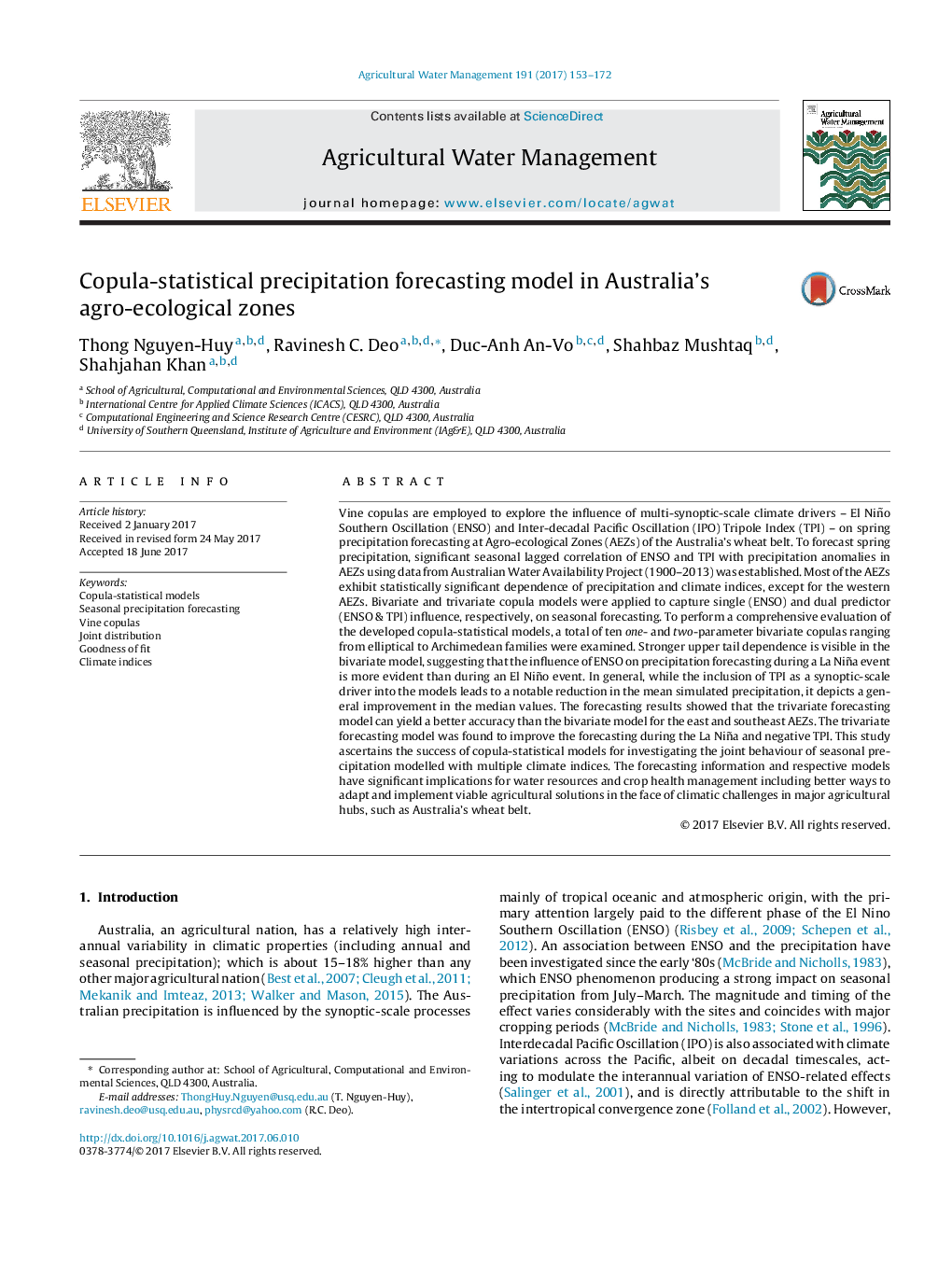| کد مقاله | کد نشریه | سال انتشار | مقاله انگلیسی | نسخه تمام متن |
|---|---|---|---|---|
| 5758302 | 1622889 | 2017 | 20 صفحه PDF | دانلود رایگان |
عنوان انگلیسی مقاله ISI
Copula-statistical precipitation forecasting model in Australia's agro-ecological zones
ترجمه فارسی عنوان
مدل بارش پیش بینی بارش آمپول در مناطق زراعی و زراعی استرالیا
دانلود مقاله + سفارش ترجمه
دانلود مقاله ISI انگلیسی
رایگان برای ایرانیان
کلمات کلیدی
مدل های آماری کوپولا، پیش بینی بارش فصلی، کاسه وین توزیع مشترک، برازش، شاخص های آب و هوا،
موضوعات مرتبط
علوم زیستی و بیوفناوری
علوم کشاورزی و بیولوژیک
علوم زراعت و اصلاح نباتات
چکیده انگلیسی
Vine copulas are employed to explore the influence of multi-synoptic-scale climate drivers - El Niño Southern Oscillation (ENSO) and Inter-decadal Pacific Oscillation (IPO) Tripole Index (TPI) - on spring precipitation forecasting at Agro-ecological Zones (AEZs) of the Australia's wheat belt. To forecast spring precipitation, significant seasonal lagged correlation of ENSO and TPI with precipitation anomalies in AEZs using data from Australian Water Availability Project (1900-2013) was established. Most of the AEZs exhibit statistically significant dependence of precipitation and climate indices, except for the western AEZs. Bivariate and trivariate copula models were applied to capture single (ENSO) and dual predictor (ENSO & TPI) influence, respectively, on seasonal forecasting. To perform a comprehensive evaluation of the developed copula-statistical models, a total of ten one- and two-parameter bivariate copulas ranging from elliptical to Archimedean families were examined. Stronger upper tail dependence is visible in the bivariate model, suggesting that the influence of ENSO on precipitation forecasting during a La Niña event is more evident than during an El Niño event. In general, while the inclusion of TPI as a synoptic-scale driver into the models leads to a notable reduction in the mean simulated precipitation, it depicts a general improvement in the median values. The forecasting results showed that the trivariate forecasting model can yield a better accuracy than the bivariate model for the east and southeast AEZs. The trivariate forecasting model was found to improve the forecasting during the La Niña and negative TPI. This study ascertains the success of copula-statistical models for investigating the joint behaviour of seasonal precipitation modelled with multiple climate indices. The forecasting information and respective models have significant implications for water resources and crop health management including better ways to adapt and implement viable agricultural solutions in the face of climatic challenges in major agricultural hubs, such as Australia's wheat belt.
ناشر
Database: Elsevier - ScienceDirect (ساینس دایرکت)
Journal: Agricultural Water Management - Volume 191, September 2017, Pages 153-172
Journal: Agricultural Water Management - Volume 191, September 2017, Pages 153-172
نویسندگان
Thong Nguyen-Huy, Ravinesh C. Deo, Duc-Anh An-Vo, Shahbaz Mushtaq, Shahjahan Khan,
